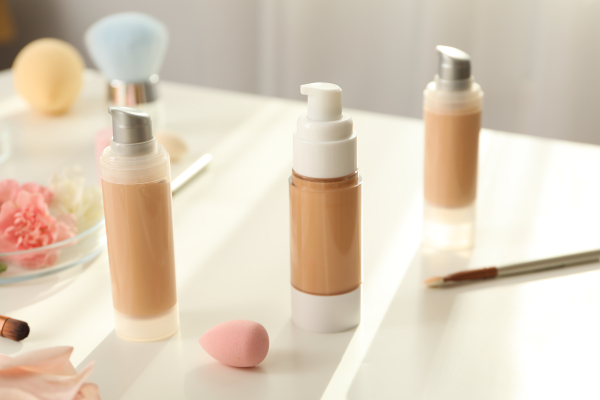Choosing the Right Foundation for Your Skin Tone: A Comprehensive Guide
 Finding the perfect foundation is a crucial step in achieving a flawless makeup look. However, with the vast array of products available, selecting the right one can be overwhelming. This guide will walk you through the essential steps to help you choose the best foundation for your skin tone, ensuring a natural and seamless finish.
Finding the perfect foundation is a crucial step in achieving a flawless makeup look. However, with the vast array of products available, selecting the right one can be overwhelming. This guide will walk you through the essential steps to help you choose the best foundation for your skin tone, ensuring a natural and seamless finish.1. Understanding Your Skin's Undertone
Before diving into foundation shades, it's important to understand your skin's undertone. Your undertone is the subtle hue beneath your skin's surface that affects its overall color. There are three main types of undertones: warm, cool, and neutral.
Determining Your Undertone
Warm Undertones: If your skin has a golden, yellow, or peachy hue, you likely have warm undertones. Veins on your wrist may appear greenish.
Cool Undertones: Pink, red, or blue hues characterize cool undertones. Veins on your wrist may look bluish or purple.
Neutral Undertones: A mix of warm and cool undertones, resulting in a balanced complexion. Veins on your wrist may appear blue-green.
2. Choosing the Right Shade
Once you've identified your undertone, the next step is selecting a foundation shade that matches your skin tone. The right shade should blend seamlessly with your neck and chest, creating a natural look.
Testing the Foundation
Test the foundation on your jawline or inner wrist in natural light to find the best match. Avoid testing on your hand, as it can be a different color than your face. Allow the foundation to set for a few minutes to see if it oxidizes, which can alter the shade.
3. Types of Foundations
Foundations come in various formulations, each catering to different skin types and coverage preferences. Understanding the different types can help you choose the one that best suits your needs.
Liquid Foundations
Liquid foundations are versatile and suitable for most skin types. They offer buildable coverage, ranging from light to full, and come in various finishes, including matte, dewy, and satin.
Powder Foundations
Ideal for oily and combination skin, powder foundations provide a matte finish and help control shine. They offer light to medium coverage and are easy to apply for a quick touch-up.
Cream Foundations
Cream foundations are thick and offer full coverage, making them perfect for dry and mature skin. They provide a radiant finish and can double as a concealer for spot coverage.
Stick Foundations
Stick foundations are convenient and travel-friendly. They offer medium to full coverage and can be used for contouring or as a concealer.
4. Coverage and Finish
The coverage and finish of a foundation are essential factors to consider when choosing the right product. Your preference for a natural or full-coverage look will determine the type of foundation you select.
Coverage Options
Light Coverage: Provides a sheer, natural look, perfect for everyday wear. Ideal for those with clear skin who want a minimalistic approach.
Medium Coverage: Offers more coverage than light but still looks natural. Great for evening out skin tone and covering minor imperfections.
Full Coverage: Provides the most coverage, concealing blemishes, scars, and discoloration. Best for special occasions or those who prefer a flawless finish.
Finish Options
Matte Finish: Ideal for oily skin, as it controls shine and offers a smooth, flat look.
Dewy Finish: Provides a luminous, radiant glow, perfect for dry or mature skin.
Satin Finish: Offers a natural, skin-like appearance, suitable for most skin types.
5. Application Tips
Applying foundation correctly is crucial for achieving a flawless look. The right tools and techniques can make a significant difference in the final result.
Tools for Application
Brushes: Ideal for precise application and blending. Use a flat foundation brush for liquid foundations and a dense brush for powder foundations.
Sponges: Perfect for achieving a seamless, airbrushed finish. Use a damp sponge for liquid foundations and gently press it into the skin.
Fingers: Great for quick application and blending, especially for cream foundations. The warmth of your fingers helps the product melt into the skin.
Techniques for a Flawless Finish
Start with a clean and moisturized face.
Apply a primer to create a smooth base and extend the foundation's wear.
Use a small amount of foundation and build up coverage gradually.
Blend the foundation into the skin using a brush, sponge, or fingers, focusing on areas that need more coverage.
Set the foundation with a translucent powder to prevent creasing and extend its longevity.
6. Seasonal Considerations
Your skin tone can change with the seasons, so it's essential to adjust your foundation accordingly. During the summer, you may need a slightly darker shade due to sun exposure, while in the winter, a lighter shade may be necessary.
Adapting Your Foundation Routine
Consider mixing two shades to create a custom match or using a bronzer to add warmth to your complexion. Keep a separate foundation for different seasons to ensure a perfect match year-round.









